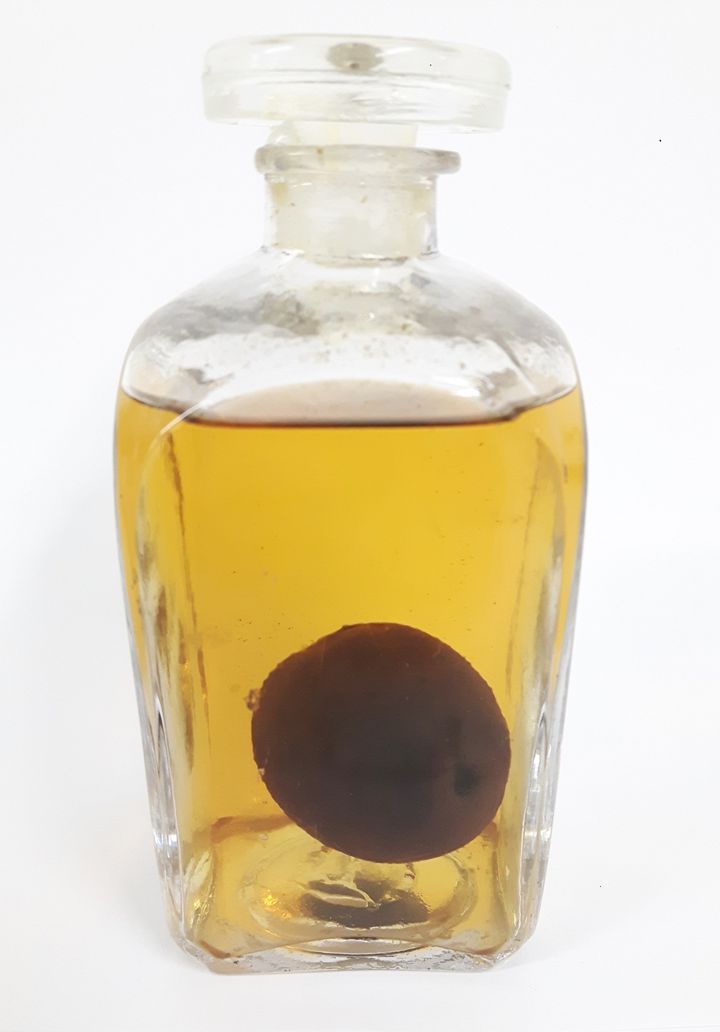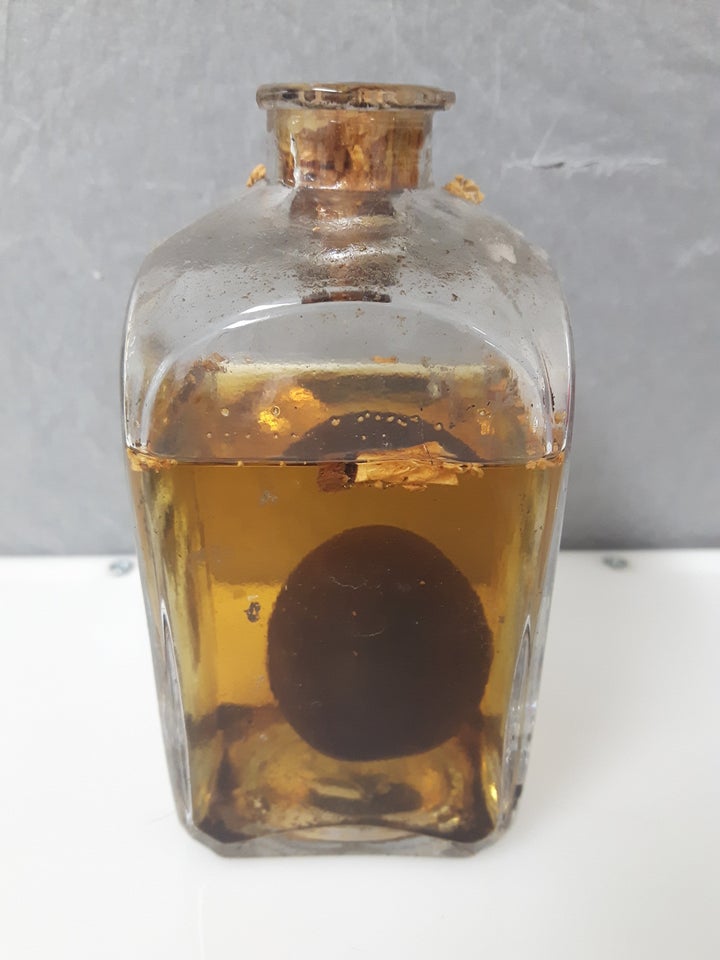
The year was 2011, and a curator at the Grant Museum of Zoology at University College London was staring intently at a glass bottle of putrid, yellow liquid with an unidentified round, squishy orb floating inside. What, he wondered, could it be?
He gathered other museum employees to discuss. They assumed, given the bottle’s lodging in a university museum’s permanent collection, it must have some scientific or historical significance. He racked his mind thinking of all the possible bodily parts the globular mass resembled: testicles, tumors, echinoderms, eggs, eyes. Perhaps it was an inflated pufferfish or a hedgehog curled up? Nothing seemed quite right.
And then it hit them.
The gaggle of museum experts were not staring intently at some mysterious, dead animal, but, in fact, at a piece of fruit of the subgenus Prunus. It was a regular, shmegular plum from, they’d later deduce, a sort-of-old bottle of booze with no historical value whatsoever.
In a delightful March 22 blog post titled “When Museums Get it Wrong — Did We Accidentally Accession Someone’s Holiday Booze?” museum manager Jack Ashby admitted that a novelty bottle of plum brandy likely snuck its way into a museum vault.
According to Ashby, university collections once came together far more, erm, casually than they do now. Today, objects are introduced to museums like the Grant through “strategic, policy-led acquisition pathways of objects with detailed life histories,” as Ashby put it. But back in the day, when notable researchers retired or passed away, museums would often absorb their entire collections. And they’d sometimes push off the laborious process of documenting each of the various objects being acquired until later down the line. Sometimes, that “later” never came.
It is possible, then, that while cleaning out some important scientist’s office, a rogue container of brandy resting on a desk was assumed to be as academically important as all the other bottles of dead things around it. (Some employees really did mistake the bottle’s round fruit for a testis.)
“We operate under the assumption that all of the specimens physically now in the collection belong to the collection, unless proven otherwise,” Ashby said. Therefore, once the plum made it into the museum door, it became quite unlikely the plum would ever leave.
I reached out to Ashby to get a little more juice on the plum.
What does your job as the manager of the Grand Museum of Zoology entail?
I have strategic overview across the museum. A big part of it is making the museum collection most useful both for the public and for academic research.
Around how many objects are in your collection?
Around 68,000. It’s not a huge collection but keeps us busy enough.
That sounds like a lot to me!
Well, the Natural History Museum, London has 80 million objects.
Oh wow. And what kinds of things do you normally house in your museum?
We collect animals from all across the world throughout all of geological time, everything from a half billion years ago to today. Mostly, however, we have skeletons and skulls preserved in jars. Taxidermy just isn’t as useful for research purposes, so we have a heavy bias towards skeletons and things in jars.
How many of the objects are unmarked?
More than half are properly accessioned. That means we know what more than half are and where they live in storage. The rest is a real mix. Many are documented by paper records. The collection has been around since 1828, so we’re still catching up with getting all the information in there digitally. And there is a portion that isn’t numbered or documented.
What initially drew your colleagues, in 2011, to the bottle of brandy in question? Was there something particularly unusual about the circular object inside or do these kind of debates happen often?
[Curator Mark Carnall and and museum assistant Emma-Louise Nicholls] were just going through a certain rack of shelves and thought, what’s that? Not many parts of animal bodies are, well, plum shaped. Plus it was so smooth and all the same color, in this little historic-looking square bottle.
Would you say this was this a quick discussion or an more of an obsession?
What starts as a routine task prompts a question and then another question and another, and eventually you go down the rabbit hole and finally say, this isn’t something I can spend time on anymore.
When your colleagues agreed that the specimen was in fact a plum, was that the end of the conversation?
Yes, these little mysteries come up. It being a plum makes it a low priority for us spending much time on it. We put it back where it was. Life goes on.
Is there any reason you can think of that a plum would non-accidentally end up in the museum collection?
Not really. My colleague Hannah accessioned it this week and we labeled it “Bot 8.” (Bot is short for botanical.) So we do not have a lot of plants in the museum. We have eight now. Which is to say, it’s unlikely the plum was strategic.
What happened to the plum next?
It sat on a shelf in storage.

Then in 2016, the plum was conserved by a professional conservation team. How did that happen?
We were doing this big project to conserve the wet specimens that were drying out. The conservation team was working on a conveyor belt, where you take a specimen, spruce it up, put it back. They were going shelf by shelf and suddenly I was like, “Oh! You’ve conserved the plum!” They were like, “Yeah.”
Why did they feel the need to conserve the plum in the first place?
It was dehydrating. The fluid had dropped below the proper level. And it had a cork stopper; we don’t like cork stoppers.
Did the conservators try to definitively discern what was in the bottle?
Sometimes conservators can smell what the fluid is or test its density. If it’s anything unusual, though, they can’t work out what it is. They thought it was odd, thick and smelled sweet. They didn’t know what it was. So they disposed of the fluid and replaced it with a standard 80 percent alcohol formula, mostly ethanol with a tiny percent of methanol and water.
Are there other accidental or unusual objects in your permanent collection?
Not as strange or out of place as this. We have 9,000 mice. It might seem like, why would a museum have 9,000 mice? Well, because one academic collected mice from different islands all around the world to study the effects of evolution on different islands. Because he had them, we have them.
My favorite strange museum thing, though, is an opossum in fluid. We found there was orange crud on its fur so we took it out and cleaned the specimen and found that the orange gunk was coming from a wad of fabric in the opossum’s stomach cavity where the organs had been removed. We took the fabric out and unwrapped it and found a D-type Duracell battery in the cavity. That’s what the orange was ― liquid rust. But the question really is, why has someone stuffed a battery in an opossum?
Back to the plum. What is your theory as to how it arrived in the museum?
My theory is that it was a bottle of plum brandy and was accidentally roped in with a collection from someone’s office or one of the universities that was shut down.
What will happen to it now?
Since we don’t know for a fact this is what has happened, we don’t have enough information to dispose of it. We can’t prove it’s plum brandy. We can’t prove it hasn’t got research value. It probably doesn’t, but it costs more to dispose of it than to keep it. And who knows? We might find a letter one day saying this is a very important plum.
I like this story because in the museum world we hear things in the news about museum curators discovering new species of dinosaurs, or something. In this case, we didn’t find an amazing dinosaur. We found a really useless bottle of brandy.
Have you ever had the urge to taste the plum to prove its plumhood?
Certainly not now because the fluid has been replaced with alcohol. If I had been there with the conservators [Lucie Mascord and Emilia Kingham], I don’t think I would have tasted it, but I would have given it a big whiff.
Do you have a favorite object in the museum collection?
My favorite is a taxidermy platypus. It is a nice taxidermy platypus.
Do you ever give the objects names?
There are a handful of specimens with names. My platypus doesn’t have one. There’s a taxidermy chimp we refer to as Chimples.
Do you think the plum will become valuable now that it’s in a museum collection? Do all the items in your collection get financially evaluated?
It’s very hard to put a value on these natural history objects. You might come up with a value of how much it would sell for at auction. But really, they each represent an individual animal that was alive at a specific time and place. You can never replace it. But if this is indeed a former bottle of plum brandy, the value is low.
CORRECTION: An earlier version of this story incorrectly indicated Ashby said there are “18 million” items in the Natural History Museum, London’s collection. He said, correctly, there are 80 million.
